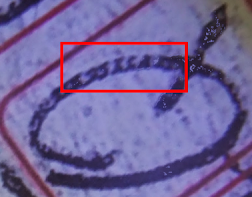Highlighted Code Page
Highlighted are a number of instances of micro written letters and numbers, some are clearer than others.
These are just some of the instances, there are more. The average size of the characters is around .5 mm in height.
These are just some of the instances, there are more. The average size of the characters is around .5 mm in height.
The details show up reasonably well in this 400 dpi image which is exactly as you will find from the University of Adelaide Wiki site.
According to Detective Brown, Jestyn's phone number was written in 'tiny handwriting', his words, and the same words were quoted by Professor Abbott in a recent radio interview.
Below, two close up views from the main code page:
Below, two close up views from the main code page:
There is a place name 'YER', in fact it's proper name is Kar-Yer in Russia. Could be, a 'YER' is also a letter/vowel from the Cyrillic alphabet and thus this could have been an overheard word? See map:
For the erudite, is that X within a circle a mathematical symbol? Or could it be part of a map?
My thoughts are that the back of the book was in use regularly as a resting place and on which other paper was placed and then written on such that we see numerous instances of what appears to be micro written words and numbers. You should also take into account the fact that whilst the code page was at 400 DPI, a moderately high resolution, it was of an original image that had been taken with glass plate photography. In other words, we have a good image of an excellent image.
Others have tried to infer that because this was a scan from the Adelaide Advertiser files then it would have collected digital 'artifacts'. Not so, the entire process of photographing an original, taking a scan of that photograph at both 400 DPI and 1200 DPI has been replicated on this blog. Further it was done using the INK H technique as used by SOE in WW2. The end result at both 400 DPI and 1200 DPI provided the exact same result as in we were able to show micro-code beneath the inked letters.
What that confirms is that micro-code exists as described in the SOE manual and indeed in an earlier CIA document as well as there being countless other examples of micro-written words, codes and numbers going back centuries. All that's been done here is to show it's use once again in an espionage setting. It is worthy of note that the person who most loudly complains about its existence is the same person that was forced to admit that he had not tested the method that I provided to him and in fact had misled his own audience to the effect that he had tested it. I find that sad. As Einstein said, "Condemnation without investigation is the height of ignorance".
Others have tried to infer that because this was a scan from the Adelaide Advertiser files then it would have collected digital 'artifacts'. Not so, the entire process of photographing an original, taking a scan of that photograph at both 400 DPI and 1200 DPI has been replicated on this blog. Further it was done using the INK H technique as used by SOE in WW2. The end result at both 400 DPI and 1200 DPI provided the exact same result as in we were able to show micro-code beneath the inked letters.
What that confirms is that micro-code exists as described in the SOE manual and indeed in an earlier CIA document as well as there being countless other examples of micro-written words, codes and numbers going back centuries. All that's been done here is to show it's use once again in an espionage setting. It is worthy of note that the person who most loudly complains about its existence is the same person that was forced to admit that he had not tested the method that I provided to him and in fact had misled his own audience to the effect that he had tested it. I find that sad. As Einstein said, "Condemnation without investigation is the height of ignorance".

























